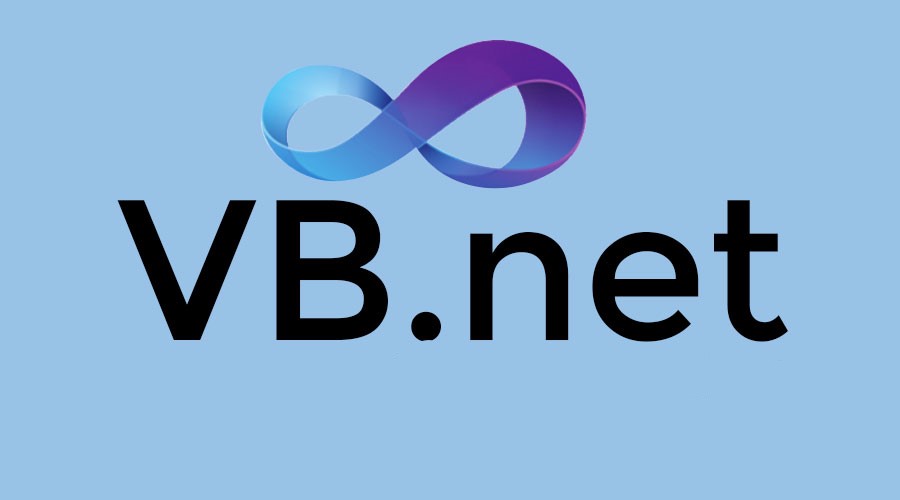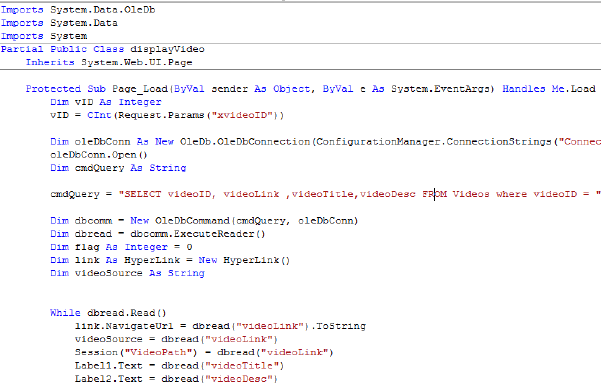VB.net
WHAT IS VB.net?
- VB.NET (Visual Basic .NET) is a programming language and development environment that is part of the Microsoft .NET framework.
- It is an evolution of the classic Visual Basic language and is designed to create Windows-based applications, web applications, and other types of software.
- VB.NET combines the simplicity and ease of use of Visual Basic with the power and capabilities of the .NET framework.
- VB.NET is based on the principles of object-oriented programming (OOP).

USE OF VB.net
VB.NET is widely used for developing Windows desktop applications. Its rich set of controls and the ability to easily create a user interface using the visual development environment make it a popular choice for building desktop applications with features like forms, menus, buttons, data input, and output.
VB.NET can also be used for developing web applications. With the ASP.NET framework, developers can create dynamic and interactive web pages, handle user inputs, access databases, and perform server-side processing. VB.NET web applications can be deployed on web servers and accessed by users through web browsers.
VB.NET provides robust support for database integration. Developers can use ADO.NET or other data access technologies to connect to databases, execute SQL queries, and perform operations like data retrieval, modification, and deletion. VB.NET allows for seamless integration with various database systems, making it suitable for developing data-driven applications.
VB.NET’s RAD (Rapid Application Development) capabilities make it a great tool for rapid prototyping. Developers can quickly build user interfaces, create mock-ups, and test functionality without investing a significant amount of time in writing complex code. This helps in quickly validating ideas and gathering feedback from stakeholders before proceeding with full-scale development.
WHAT ARE THE FEATURES OF VB.net?
Object-Oriented Programming (OOP) – VB.NET supports object-oriented programming concepts such as classes, objects, inheritance, and polymorphism. This allows developers to write code that is modular, reusable, and easier to maintain. OOP helps in organizing code and promotes code readability and extensibility.
Integrated Development Environment (IDE) – VB.NET comes with a powerful integrated development environment called Visual Studio. The IDE provides a comprehensive set of tools for code editing, debugging, and visual design of user interfaces. It includes features like IntelliSense, which offers context-aware code suggestions, and a visual designer for creating Windows forms and web pages.


Rapid Application Development (RAD) – VB.NET is designed for rapid application development, allowing developers to quickly build applications with less code and effort. It provides a wide range of built-in controls, components, and libraries that simplify common tasks, such as user interface design, data access, error handling, and application configuration.
Strongly Typed Language – VB.NET is a strongly typed language, which means that variables and their data types must be declared explicitly. This helps catch errors at compile-time and promotes code reliability and maintainability. Strong typing also enables the compiler to optimize the code for better performance.
Language Interoperability – VB.NET is part of the .NET framework, which supports multiple programming languages. This means that VB.NET code can seamlessly interact with code written in other .NET languages, such as C#, F#, and C++. This allows developers to leverage existing libraries and components written in different languages and promotes code reuse.
THE BENEFITS OF LEARNING TO CODE WITH VB.net
Familiar Syntax – VB.NET has a syntax that is similar to earlier versions of Visual Basic, making it relatively easy for developers who are already familiar with Visual Basic to transition to VB.NET. If you have experience with Visual Basic 6 or earlier versions, learning VB.NET allows you to leverage your existing knowledge and skills.
Access to .NET Framework – VB.NET is part of the .NET framework, which provides a vast array of libraries, frameworks, and tools for building applications. By learning VB.NET, you gain access to the extensive functionality and capabilities offered by the .NET framework, making it easier to develop robust and feature-rich applications.
Versatility – VB.NET can be used for a variety of application types, including desktop, web, and mobile development. It offers features and frameworks for building Windows applications, web applications using ASP.NET, and even cross-platform mobile apps using frameworks like Xamarin. Learning VB.NET opens up opportunities to work on different types of projects and expand your skill set.
Integration with Microsoft Ecosystem – VB.NET is closely integrated with the Microsoft ecosystem, including tools like Visual Studio, SQL Server, and Azure cloud services. By learning VB.NET, you can take advantage of this integration to build applications that leverage Microsoft technologies and services. This can be particularly beneficial for organizations that heavily rely on Microsoft technologies in their IT infrastructure.
